#plus a totally not foreshadowing dream sequence
Explore tagged Tumblr posts
Text
Ranking Every Studio Ghibli Movie
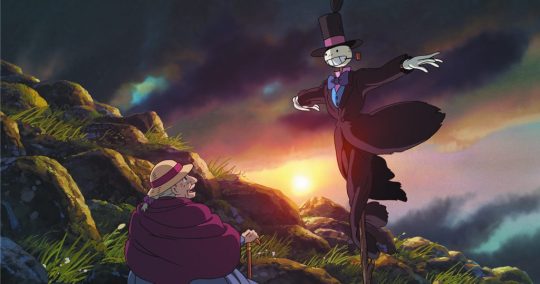
Studio Ghibli's contribution to anime (and animation in general) cannot be understated. Founded by directors Hayao Miyazaki and Isao Takahata, and producer Toshio Suzuki, the studio has produced many of Japan's most hallowed films, movies that are both critically acclaimed and monsters at the box office. In 1996, Disney partnered with Studio Ghibli to bring their movies to North America, developing a new audience that has since come to age; now, Ghibli is as much a part of American childhood as Pixar and Dreamworks releases.
On Anime Pop Heart and @beneaththetangles, we are commemorating the studio with Ghibli Month all September long! I’m kicking things off by ranking Ghibli's twenty-one releases, plus Nausicaa of the Valley of the Wind, which is often honorarily included among the studio's slate, ranked from first to worst (including alternate viewpoints on a couple of the selections).
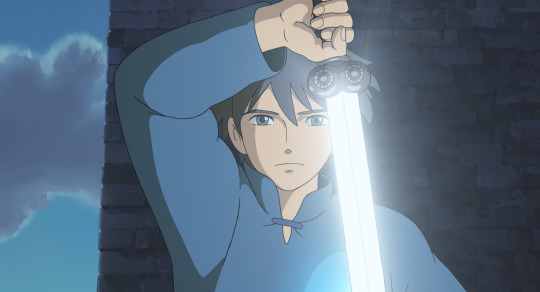
22. Tales from Earthsea
Miyazaki famously quarreled with his son, Goro, over the latter's ability to direct Tales from Earthsea, and indeeed, the final product feels like the result of a young man who was in over his head. The movie deserves its ignominious reputation, as it is inconsistent, poorly staged, and often terrible. It's a shame, too, for there are some strong elements to the film and enormous potential, with the outlines of an epic tale and compelling characters in Sparrowhawk and Cob (who are wonderfully dubbed by Timothy Dalton and Willem Dafoe, respectively)—it just never comes quite together and totally unravels at the end, resulting in the only bad film in Studio Ghibli's outstanding run.

21. The Cat Returns
Most Studio Ghibli films are family features, made for children. However, they still capture the imagination of youth and adults as well. The Cat Returns, the only "sequel" in Ghibli's film catalog, doesn't do the same however. It is purely for kids, and aside from flourishes here and there that speak of fantasy adventures and feature whimsical characters, fails to engage viewers of a certain age—maybe anyone older than about twelve. A neat companion piece to Whisper of the Heart, it's worth watching, showing to your children, and then giving away to parents who need better-than-average entertainment to busy their children.
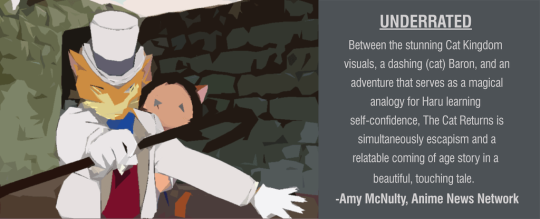
20. Ocean Waves
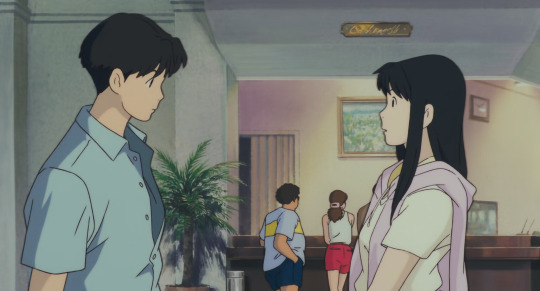
At one time, Ocean Waves was considered a black eye in Ghibli's filmography, an overpriced television movie that wasn't all that good. In retrospect, the intial judgments were only partially right. Ocean Waves is very much a TV movie, melodramatic and small in scale. The animation, too, is sometimes shoddy, but more often than not it's far better than it has the right to be. Ocean Waves is lovingly made, and the characters are almost frustratingly sincere—and oh so early 90s. While on the lowest tier of the Ghibli scale, Ocean Waves is far better than a simple curiosity.
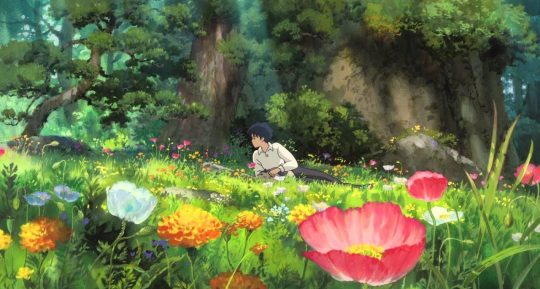
19. Arrietty
Like Poppy Hill before it, there's nothing terrifically wrong with Arrietty—it just lacks the magic of the great Studio Ghibli films, making it rather forgettable. It's also sometimes dull. While beautiful colors, a foreshadowing of the spectacular animation to come of Yonebayashi in Mary and the Witch's Flower, shine through in the film, and some of the action sequences are highly engaging, our hearts are never fully in it. Maybe that's because we lack a loving connection to many of the characters, particularly to the pensive Sho. A nice watch, but one that's lacking.
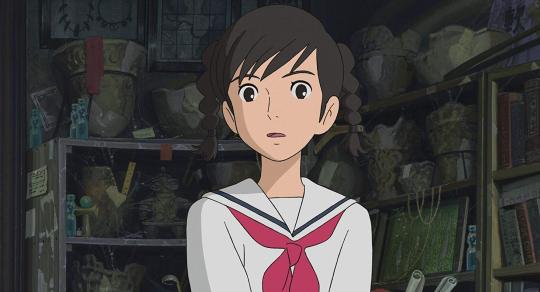
18. From Up on Poppy Hill
Much maligned for our lowest ranked movie, Goro Miyazaki returned from that entry with a stronger film, one that functions as an ode to historic preservation while presenting one of the studio's most lovely relationships—that is, until it gets a bit tricky, unfortunately begining to enter a zone unusual for Studio Ghibli, if standard fare for other anime. But that's a relatively minor issue in what's a perfectly lovely film that does well in evoking nostalgia in a movie that reminisces about the past and a Yokohama that no longer exists. Not every emotional moment hits as it should, but enough do to make the film Ghibli's best "date night" entry.
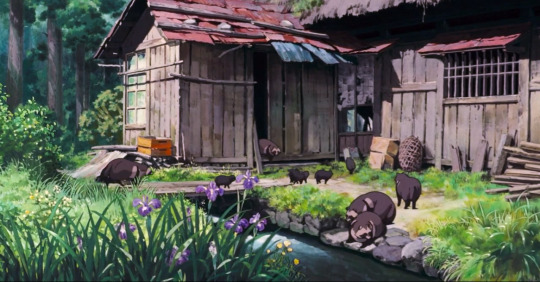
17. Pom Poko
Often criticized for being too over-bearing in its ecological message, Pom Poko's main issue instead is that it's meant to a collection of stories that to flow into one another, based on one group of tanukis' fight against urban development, but the movie doesn't feel cohesive, partly because there is no central protagonist. We only get to know each main tanuki so much, and none feel central to the tale—any could step in and play the necessary roles. Still, Pom Poko is unreservedly charming and often hilarious. It's also a peek into Japanese culture that we often don't get, a look at a country transforming in landscape and in values.
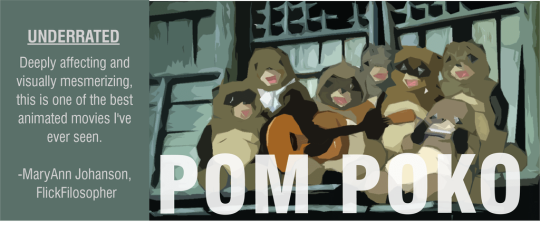
16. Ponyo
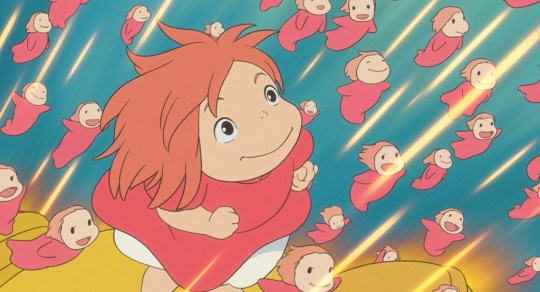
Why is Ponyo the low point of Miyazaki's output, the only film of his that doesn't attain the level of classic? It is wonderfully animated, bursting with energy and featuring a story that is never disingenuous and a heroine that is funny, cute, and breathtaking even. However, the film proved that Miyazaki was on a downward trajectory after Spirited Away. Repetition seen in Howl's Moving Castle was on full display in Ponyo, a new movie that too often feels like a rehash, featuring characters that other than the title heroine, fail to connect, and a story that is muddled and often just strange. Ponyo is a fun film and a better one after repeated viewings—the problem is that such defenses do not have to be made for any of Miyazaki's other works.
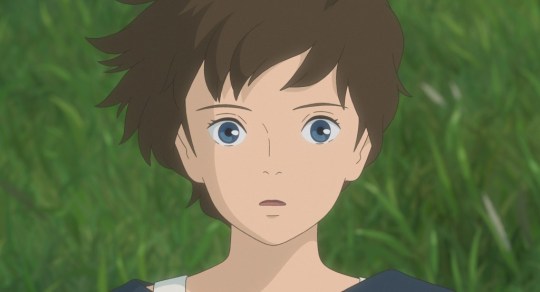
15. When Marnie Was There
The last feature film from Studio Ghibli to date is both quietly personal and a surprising risk. When Marnie Was There is the studio's first true mystery tale, and has a tone that's slightly haunting. The lead characters, also, are unusual for Ghibli—neither Anna nor Marnie are as embraceable as most of the heroines from Ghibli's past, but that seems be purposeful. What they demonstrate to us is not as much of "who we can be" but "who we are" and even so, how we can overcome. The creative energy of past Ghibli films is missing, but the replacement here by a surprising intimate tone in a modern setting is welcomed.
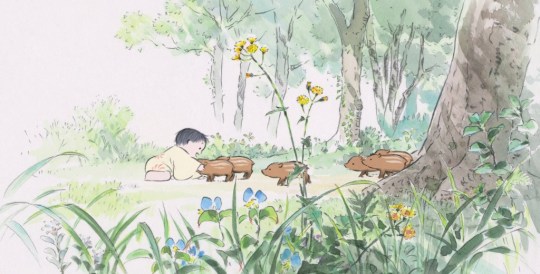
14. The Tale of the Princess Kaguya
While this notoriously expensive film flopped at the box office, The Tale of the Princess Kaguya was well-received by critics, and for good reason. Adapting a famed folk tale, the film is animated in style befitting its origins, creating the sense that the viewer has fallen into a some traditional Japanese painting. But the movie is not as pastel as its colors indicate—the storytelling is bold. It doesn't sit in the past, instead feeling remarkably current in the fable of a princess imprisoned by seemingly everyone and everything, without ever feeling worn or heavy-handed. Mystical and fantastical elements are both woven into the foundation of the story and come alive in key moments, keeping the film compelling (for the most part) throughout its two hour+ run time.
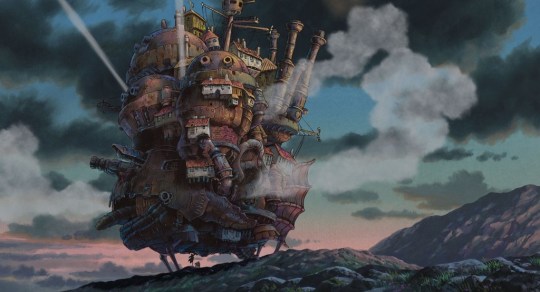
13. Howl's Moving Castle
An underrated aspect of Studio Ghibli's brilliance is in how they often adapt already-beloved works. Adapted by the master, Howl's Moving Castle, based on the novel by Diana Wynne Jones, is gorgeously animated and bold in both design and character—Howl and Calcifer, particularly, are memorable (and give strong emotional weight to the tale). While it suffers in comparison to its predecessor, Spirited Away, by being a little unwieldy, it remains a classic and an example of how well Miyazaki can bring themes and plot points across subtly (think of the flashback of Howl) in a movie that's otherwise fierce and larger than life.
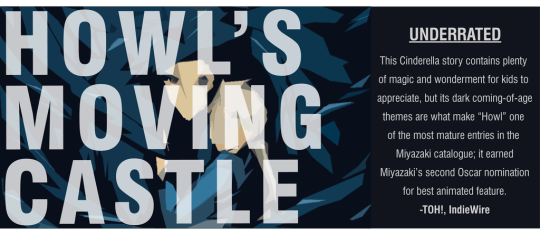
12. The Wind Rises
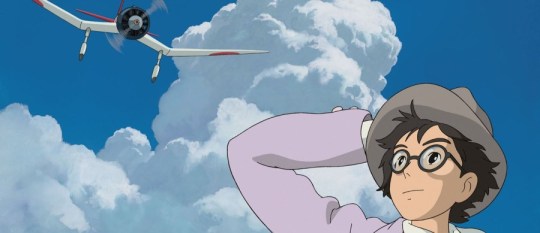
From conception, The Wind Rises was a challenging film—how do you tell the story of the man who designed a fighter essential to Japan's WWI efforts, and show him as a patriot and dreamer without excluding the crimes of the nation, or making a film that goes against Miyazaki's anti-war values? It's difficult to say if he succeeds, but the film itself is beautifully crafted. The supporting characters here are less important than in other works, so it's vital that the audience admires Jiro Horikoshi, and we do—his character and positivity make him easy to root for, and dream sequences in the film both flesh out his thought process and keep us captivated. Once believed to be Miyazaki's last film, if it had been, The Wind Rises would have been worthy of that designation.
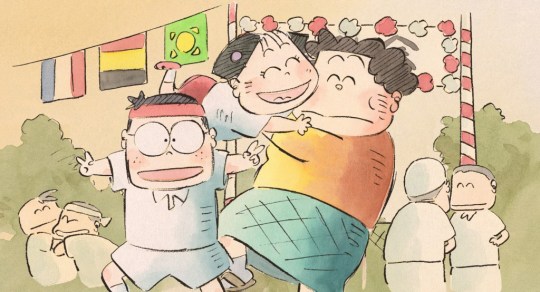
11. My Neighbors the Yamadas
The oddball in Ghibli's filmography, My Neighbors the Yamadas is presented through half-a-dozen or more short stories in the style of comic strips come to life, with animation that matches. The magic in the film is that the Yamadas are as over-the-top as the movie's aesthetic is, yet maintain an authentic feel. Think of some of the most popular family sitcoms of the 1980s and 1990s, but with an addition those shows could not feature—fantastical sequences that break in without warning and bind the ties of family further. We may not want to live like the clumsy Yamadas, but the heart of the family will make you consider whether they're the ones who really have it all together.
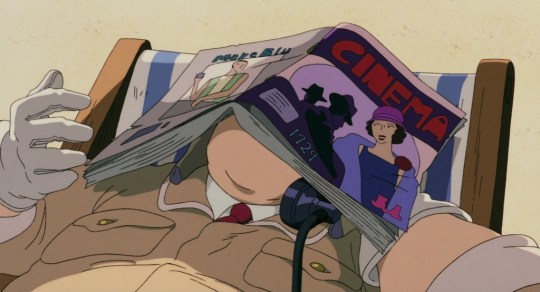
10. Porco Rosso
Studio Ghibli films share animation styles and themes, but one can never say they lack in variety when it comes to story. The tale of Porco Rosso is of an ace pilot cursed into living as a pig—but not to worry! He is still adored by women as he flies fantastic missions while running from fascists, pirates, and fame-seeking assassins. Porco is gruff and unattractive, but both he and the tale are sweet, as what's already a compelling story of WWI aces and dogfights is buffeted by grief, romance, and two strong heroines of very different types and roles. Perhaps the film with the largest range of opinion among the Miyazaki classics, Porco Rosso is nonetheless fantastic, and require viewing if you haven't watched it already.
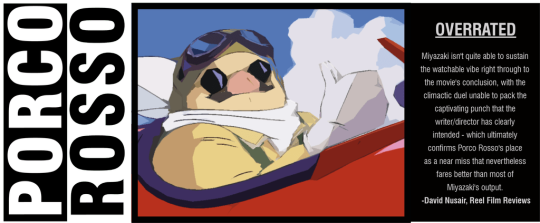
9. Whisper of the Heart
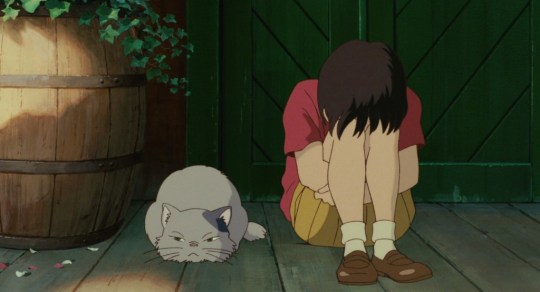
Ghibli's most unabashedly romantic film is one of its most formulaic, but still among its best. The debut film by Yoshifumi Kondō, Miyazaki and Takahata's proposed successor before he died just a few years after the movie's premiere, is at once encouraging while also refusing to shy away from the melancholy experienced by children—and adults, too—when one doesn't seem to have what it takes to become great. In joy and sadness, Whisper of the Heart lets the kids at the center of the film be kids. They are at times stubborn, silly, and immature, and by treating them that way, the movie never drifts into something banal (with the possible exception of the famously abrupt ending)—it's a lovely lesson in growing up and meeting challenges, and a personal favorite.
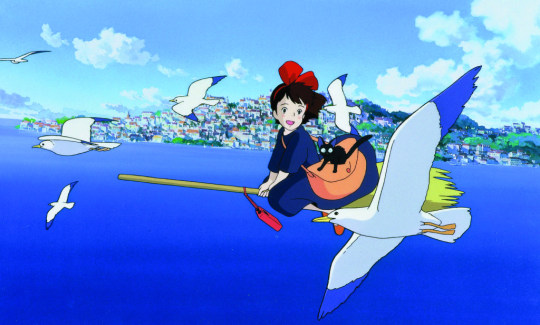
8. Kiki's Delivery Service
The charm of Kiki's Delivery Service is two-fold—in the setting, a northern European-style town that is alive, forcing the events of the story through its residents, cozy cafes, and early 20th-century transportion, and in Kiki's journey itself. Her community's tradition of sending of young witches to live by themselves at the age of thirteen sets the story in motion, and Miyazaki captures the spirit of a girl that age perfectly—in all its confusion, energy, enthusiasm, and difficulty. Kiki is not a subtle character, but her growth is. When she takes to the air for the finale, Kiki isn't experienced enough to know if she can save the day—and so we cheer when she realizes what the rest of us already know, what we've all experienced ourselves, that it takes time and failure to mold us into becoming the hero.
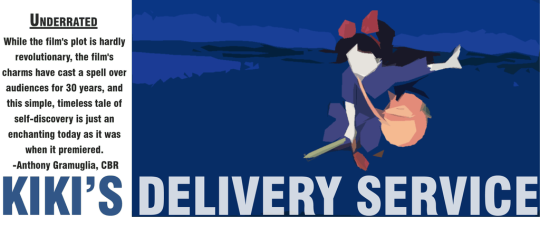
7. Castle in the Sky

Miyazaki created classic film after classic film for decades, in a streak that started with Lupin III and ended, I'd argue, with Howl's Moving Castle. Often forgotten among the wonders is Castle in the Sky, a steampunk entry that is a joyous adventure, akin to Treasure Island but developed for an audience of both boys and girls. Sumptuous cloudscapes fill the screen, as do colorful characters with meaty roles, including a group favored by Miyazaki—pirates (in this movie, air pirates led by Dola, an older female). Reflective of Miyazaki's ability to master genres, Castle in the Sky again crosses fantasy and sci-fi in perfect proportions, underscoring an uplifting tale with an apocalyptic story line.
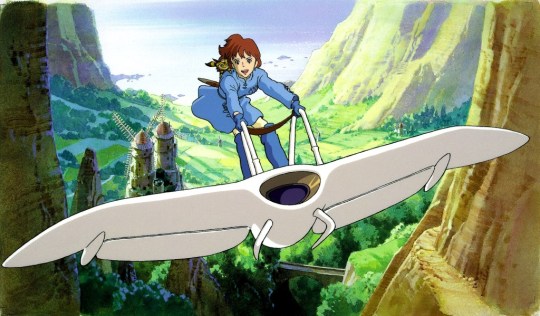
6. Nausicaa of the Valley of the Wind
Unofficially part of of Ghibli's canon, the success of Nausicaa, based on Miyazaki's own manga and exploring the ecological, anti-war, and feminist themes for which the studio's future films would be noted, launched Studio Ghibli. Nausicaa herself remains one of the studio's most iconic and compelling heroines, a physically powerful and feminine hero who must grow into adulthood very quickly while putting aside deep flaws to offer salvation to her people and land. The beautiful landscapes speaks to the epic story, better fleshed out in the manga, while reminding us that Ghibli films are giants not only in animation, but in fantasy and sci-fi realms as well.
5. Only Yesterday
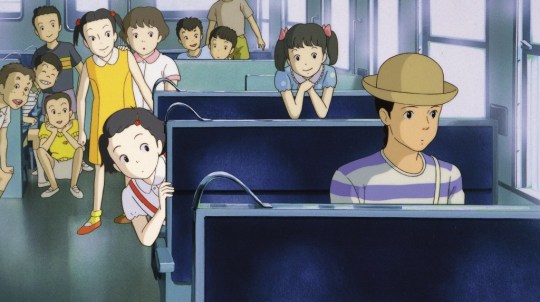
How do you create an animated film about a twenty-something woman that waxes nostalgia while on a trip to the countryside, and at the same time make it entertaining and accessible? It's not an easy task, but Only Yesterday accomplishes it fully. Taeko, the protagonist, explains, "I didn't intend for ten-year-old me to come on this trip, but somehow, once she showed up, she wouldn't leave me alone." We experience her nostalgia for and complicated feelings about the past through a family that's genuinely flawed, while experiencing her visit to relatives in the countryside in the present, a trip that is subtly life-altering, one that pushes her to consider who she is and who she wants to be. Oh, and the film also features one of anime's most wonderful endings, set to a cover of a now-classic love song.

4. Grave of the Fireflies
It's a testament to Miyazaki's stature that the first three Ghibli films on the list are all directed by him, and also to the supreme talent of the other directors that their films rise above some of his other tremendous work. Directed by Studio Ghibli co-founder, the legendary Isao Takahata, Grave of the Fireflies is the most painful and emotional movie in the canon; it is also one of the greatest war movies ever made, using animation to deftly explore the how war victimizes children. Opening and closing shots, both of which express the uncaring nature of bystanders (and by extension, the world) toward children cause us to wonder what we really feel about the world's most vulnerable population.
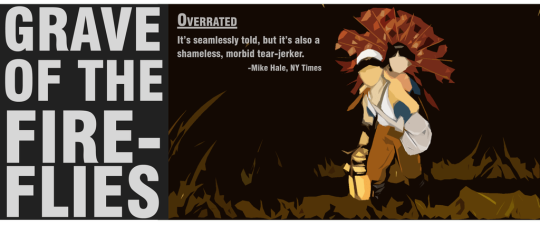
3. My Neighbor Totoro
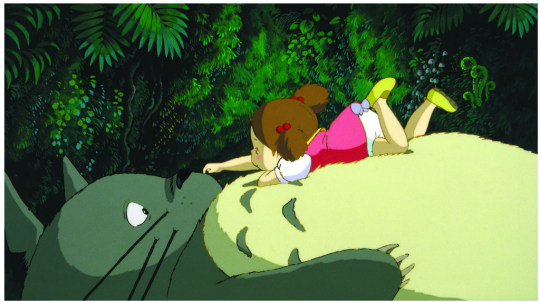
It's often said that nothing really happens in My Neighbor Totoro—but that's part of the magic of the film. A child's movie in all ways, including in the action, which revolves around a sick mother, a move to a new house, and a lost child, the film finds its center in a magical being that never says a word (Totoro only growls), and about whom many theories abound. If Totoro is a figment of Satsuki and Mei's imaginations, he is then similar to Winnie the Pooh, a necessary presence in the lives of a child character (two of them, sisters, in this case) who is growing up in a difficult situation, not to adulthood, but to the next step in the journey of life.
2. Spirited Away

Miyazaki has retired and unretired several times—when did so following Princess Mononoke, he returned with what is often considered his magnum opus, Spirited Away. At once deeply Japanese and completely accessible, the movie takes viewers on one of the most remarkable visual journeys ever put to film, a feast that never relents through its entire run time. Perhaps underrated is Miyazaki's decision to move the action away from the bathhouse for much of the final act, a quiet last leg that is key to Chihiro's journey, as well as for many of Spirited Away's supporting characters. Absolutely deserving of all love and acclaim.
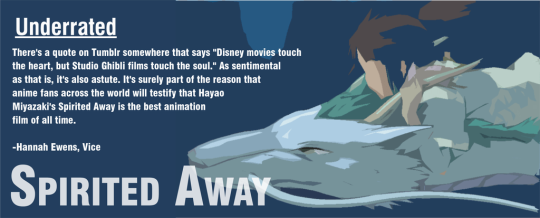
1. Princess Mononoke
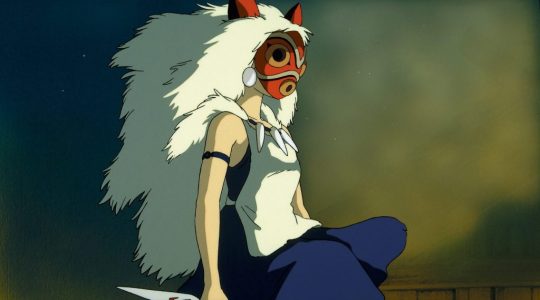
Studio Ghibli's finest film is also perhaps its most surprising. Visceral, violent, and conflicting, Princess Mononoke is no easy tale to absorb. There is no "good guy," not in the traditional sense, as Miyazaki explores hist favored ecological theme but through the lens of humanity struggling to survive in a world where they are just surpassing nature, the beast gods and goddesses who had previously ruled. It is an epic in the vein of films from decades before with vibrant and complex characters, ground-breaking animation, and an English voice track that is second to none. The studio's most intricate work, Princess Mononoke requires multiple viewings to fully appreciate.
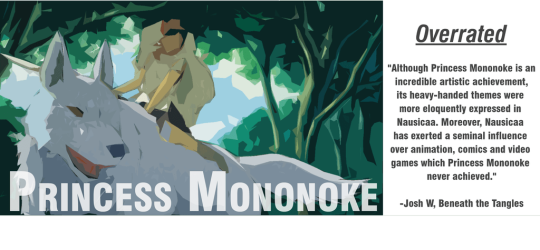
--
All Studio Ghibli movies are available for sale, including many in special collectible editions. We encourage you to go check them out!
157 notes
·
View notes
Text
Try, Try Again (pt. 8)
(Cpt 1) | (Cpt 2) | (Cpt 3) | (Cpt 4) | (Cpt 5) | (Cpt 6) | (Cpt 7) || (AO3) Thanks to everyone that left such lovely comments on the last chapter! You guys made my whole week :D
Also, I forgot to mention this last time, but Bonus Points to anyone that can guess why the ship is named the Gemini.... Chapter 8 (3314 words)
ABOUT THREE YEARS AGO
Bianca opened the door with one hand, carefully balancing her newest spaceship in the other. Finn would like this one, she was super sure.
Dad had helped her with the really tricky bits, since some Legos were still too small and finicky for a seven year-old to use, but she had built most of it herself. Plus, she had done all the stickers and decorating as well.
Looking down the stairs, she couldn’t see any sign of her brother. Tentatively, she set the Gemini aside, placing it on top of one of the many shelves lining the side of the staircase.
“Finn?” She called out his name as she flounced downstairs, running a careful hand along the banister. The basement was silent in response, aside from the low rumble of the dryer.
In her brother’s absence, Bianca’s attention turned to the large table where his Legos were set out. The city of Bricksburg looked pretty much the same as when she’d last seen it, which was to say that it looked pretty rough. The last time that they’d “played” together, they had ended up arguing over a particularly cool minifigure and Bianca had accidentally smashed her elbow into one of the taller skyscrapers, totally destroying it. And then, when Finn tried to swoop in and catch the top of the building, he had only succeeded in toppling its neighbor as well.
Bianca frowned at the memory. She hadn’t meant to break the tower, and she hadn’t meant to make Finn so grumpy either. It seemed like everything she did made him mad though, and he never wanted to play the same games as her either.
She looked over towards where Finn kept his favorite minifigures. He almost always played with the same ones, and he never let her play with any of them, even though he had so many.
Bianca reached over, plucking Batman’s figure from where he’d been positioned behind some kind of turret gun.
Batman was the coolest of all Finn’s superheros, Bianca thought. Her brother had given her some other ones, like Wonder Woman and the green guy, a while back so that she’d stop bothering him about it. And then, he hid Batman for a while. She didn’t know how long, but it seemed like approximately the amount of time it takes to produce a feature length animated film... or something.
Regardless, he was back now.
Bianca liked Batman because he seemed lonely, like he needed a friend to give him hugs or throw him a party. Sometimes she felt lonely like that, but she had her mom and dad, and from what she’d heard, Batman didn’t.
Holding him in her hand, Bianca wondered if Batman missed his superhero friends. They were all up in her room, maybe she ought to take-
The door to the stairs opened with a bang.
“Bianca?” Finn called out as he raced down the stairs. “You better not have broken anything. That new tank took me hours to build.”
He pulled up next to her, inspecting the area for damage.
“I didn’t break your dumb tank.” Bianca stuck her tongue out at his back. “I just came down here to show you something.” She turned to go retrieve the Gemini when Finn suddenly whipped around.
“Where’s Batman?” He exclaimed. “He’s supposed to be piloting the whole thing.”
“He’s right here!” Bianca extended her arm, the plastic figure still clenched in her hand.
“Give him back!” Finn grabbed her wrist with one hand and began to pull at Batman with the other.
“Hey!” Bianca yelped. “Let go!”
Finn released her arm and pressed the fist holding Batman against his chest, as if to shield it from her. “You’ve got to stop taking my guys, Bianca,” he muttered darkly.
“I wasn’t taking him,” Bianca bristled. “I was just looking!”
“Uh huh,” Finn scowled. “The same way you were ‘just looking’ at the Justice League?”
“You gave me those guys!”
“Did not!” Finn rebutted. “And I want them back.”
“You can’t do that,” Bianca wailed.
“Can so.”
“Argh!” Bianca tugged at her hair and screamed just a little bit. “You’re the worst!”
Angrily, she stomped up the stairs as loudly as she could, and slammed the door behind her.
Finn’s expression sagged. Quietly, he turned back to his worktable and placed Batman into his seat. As he did so, his attention fell on the little vehicle nearly obscured by Batman’s tank. Gently, he picked the little car up, opened the door, and removed Emmet’s figurine.
Holding the construction worker tenderly in his palm, Finn couldn’t help but remember all the cool adventures he had made up for his little buddy. About a month ago, when they were shopping for new school supplies, his mom had bought him a big notebook just for writing down some of his stories. He had already filled out a good handful of the pages and had even let Bianca draw in some illustrations.
He had taken the notebook with him when he went to middle school orientation last week. When the teacher had made his small group go around and share, he had told them that his name was Finn and he liked to play with his Legos and write stories.
Afterwards, a couple of the kids had asked to see his notebook, and he’d nervously complied. They read through the first few pages, and then most of them seemed to get kind of bored. One kid flipped through the whole book really fast, stopping abruptly on a picture of Unikitty that sprawled messily across both pages.
The kid laughed, and Finn felt his stomach churn. He suddenly felt like the whole world was ending and the only thing that would stop it would be to snatch his notebook back and hide it somewhere far away. But, the other kids were still holding it and so he’d probably just rip it if he tried.
“Um, actually,” he stammered, “that one is my sister’s character. Mine, uh, mine has huge fangs and huge claws and uh, can shoot missiles.”
The kids tittered appreciatively at the thought of missiles and cool explosions, but it didn’t make Finn feel as good as he thought it would have.
Looking down at Emmet, all Finn could see now were the things he couldn’t do. He couldn’t shoot missiles, or do backflips, or take out bad guys, or impress anyone. He wasn’t cool or tough or important or interesting or special. He was embarrassing.
The sharp plastic edges of the figurine started to jab into Finn’s clammy fingers uncomfortably, causing him to realize how tight his grip had become. Dimly, Finn knew that he wasn’t really upset at Emmet, that it was silly to be upset at a toy. But given that he was a ten year-old boy, the idea of disliking a thinly veiled self-insert was a much more palatable concept than the alternative.
Setting Emmet back down, Finn turned away, walking up the stairs and out of the basement. As he did so, he failed to notice the newest addition to the downstairs’ collection, and so the Gemini was left to collect dust.
*******************
“Wow, Nova,” Emmet grinned. “That was a really great story. And so well told, too. I’m really glad I heard it and not like, some kind of fourth-wall breaking, real world analog instead.”
“Pssh,” Nova scoffed, an embarrassed flush rising on her ears. “It was whatever.”
Suddenly, her comm blipped loudly. Nova reached down, pressing a button on her belt to accept the call, and Catastrophe’s voice blasted out.
“HELLO? NOBLE?”
She sighed. “Literally who else would it be, Major?”
“GOOD POINT.” Catastrophe coughed awkwardly, causing a jolt of feedback. “ANYWAYS, I HAVE RETRIEVED THE REST OF GROMMET’S CREW AND WE’RE WAITING FOR YOU DOWN BY THE MAIN ENGINE.”
“Oh!” Nova’s expression brightened. “Alright, we’ll be down in a minute.”
“ALSO PLEASE BRING SOME BAND-AIDS.”
Nova said something in response, but Emmet didn’t hear it.
The main engine, he thought. That’s what I’m supposed to destroy. Nova’s story still echoed in his mind however, and he couldn’t help but feel ashamed for thinking about destroying a lost and unarmed ship.
His guide turned toward him, oblivious to his current thoughts. “Come on, dude,” she smiled gently. “You’re gonna love this.”
Quietly, Emmet followed.
*******************
The engine was big.
Logically, Emmet had known this. He’d seen it on the map earlier, and he remembered thinking to himself wow, that’s pretty big.
However, seeing it in person, he was utterly struck with the realization that the engine was BIG.
It was at least two, if not three, stories tall, and it seemed to stretch back infinitely into the ship. The fact that it was constructed out of millions of intricate interlocking pieces only added to the illusion, giving it complexity and depth.
Even though it was completely off, the way that his eyes couldn’t help but trace the convoluted gears and tracks and tubing of the machine gave it the illusion of movement.
Beside him, Nova nudged his shoulder. “It’s pretty, isn’t it.”
Still bewildered, Emmet couldn’t do much more than nod in mute agreement.
“When it’s on,” she pointed up towards an array of delicate shapes and figures littering the engine, “those all dance and twirl and spin around.” Half turned towards her, Emmet could see how her amber eyes seemed to glow with raw adoration. She was smiling, really smiling, and in the light of the engine room, he suddenly noticed that she had a spattering of light freckles that sprawled across her dimpled cheeks like constellations.
“ATTENTION EVERYBODY.” Catastrophe addressed him and the five raptors that were standing morosely in the corner of the room.
“I UNFORTUNATELY CANNOT TURN ON THE ENGINE FOR YOUR DELIGHT AND AMUSEMENT. AS SUCH, I WOULD LIKE TO ASK YOU TO PLEASE IMAGINE THAT IT IS WHOOSHING AROUND AND BEING REALLY SUPER COOL.”
They gave a stiff bow. “THANK YOU FOR YOUR COOPERATION.”
For a few minutes, they all stood quietly in front of the engine. Emmet tried his hardest to imagine it in motion, like the Major had requested, and frankly it did seem super cool. Eventually though, Catastrophe spoke up again.
“ATTENTION AGAIN, PLEASE.” They rasped. “IT IS NOW BEDTIME. NOEL, PLEASE ACCOMPANY THE BITEY ONES BACK TO THEIR ROOMS, AND I WILL ESCORT EMILY-”
“Emmet.”
“YES, OF COURSE. I WILL ESCORT HELMET BACK TO HIS ROOM.”
“Ugh,” Nova grumbled. “Yeah, yeah, alright.” She grabbed the first aid satchel back from the Major and started to herd the raptors out of the room.
“SO,” the Major took Emmet by the elbow and started to lead him down the opposite corridor. “WHAT DID YOU THINK OF THE ENGINE?”
“It’s awesome,” Emmet beamed. “I kinda wish I could see it in action.”
Catastrophe stared at him for a moment, just long enough to make it awkward. “I SEE,” they eventually wheezed before leading him towards his bedroom in relative silence.
When they reached the room, the door hissed open automatically. Emmet stepped into the doorway and couldn’t stop himself from gasping. It was like a luxury hotel room, spacious and well-furnished. He turned back to ask the Major if they’d gotten the right room, but they were gone.
Alone now, Emmet wandered over to sit on the bed. It was absurdly soft and he couldn’t resist the urge to lie down, pausing only to brush off a few of the decorative pillows and stuffed animals that were taking up the majority of the bed’s surface. In a flash, all his exhaustion caught up to him, and he realized that he probably wasn’t going to get back up until morning.
Absent-mindedly, he picked up one of the stuffed toys that was digging into his side. It was a blue bear, like the one he’d had as a child, long before the world had ended twice-over.
He frowned. Everything had been so simple this morning, when the Gemini was just a vague threat and there was a straightforward plan to follow. But now, he couldn’t be sure what to do. If he didn’t destroy the engine, then he would fail the seminar and let all his friends down. But if he did destroy it, then Nova and Catastrophe could be stuck here forever.
Laying on his back, Emmet let his worried thoughts roll through his mind again and again until he slipped into a vague sort of sleep.
*******************
Apocalypseburg was crumbling. The buildings, the vehicles, even the ground itself was fracturing into a thousand tiny shards. The world was ripping itself apart, accompanied by a symphony of distorted screaming voic-
Lucy fell to the ground, hard. A yelp escaped her lips before she could help it. She looked up, her face twisted in pain, a trace of blood trickling past her brow. There was fear in her ey-
The Rexcelsior streaked through space, its engines gleaming, clearly working at full power. Suddenly, something unseen struck its side, exploding against the hull in a brilliant blast of light. The ship shuddered, rocked by the force of the explosion, sending small sections of ship careening into the void. Its attacker swerved around, avoiding the debris, their guns shimmering as they prepared another volley.
It was the Gemini.
Fully operational.
Its rear engines were spinning, smearing a shimmering golden trail against the backdrop of spa-
Emmet jerked awake. His heart was pounding in his chest, threatening to leap past his ribs altogether.
It was just a dream, he thought. A- a nightmare maybe. Either way, it wasn’t real.
But… it had felt real.
Suddenly, Emmet realized that he was incredibly uncomfortable. His bed was too warm, despite the thinness of the blanket. He needed to get out.
He stood up, feeling the chill of the night air in the sweat on his back. For a moment, he considered calling Rex, telling him about the dream. It usually helped to talk about these things, but… Emmet couldn’t impose.
It hadn’t been that bad of a dream, he told himself. He could deal with it himself. He’d just go for a quick walk, just to get his mind off things. That was all.
He stepped out into the hall. The overhead lights were off, but a thin strip of LEDs near the floor emitted a faint blue glow that allowed him to see well enough. He tried to walk gently, so as not to disturb anyone that might still be sleeping. As he was pacing past the bridge, he stopped to look out the vast window.
It was so quiet and still. Outside the window, glastroids floated by, slowly spinning past one another. The stars in the distance glimmered, and Emmet felt a little better just watching them. He leaned against the dashboard, cupping his cheek in one hand as he stared dreamily out of the window.
Suddenly, a light on the dash illuminated. Startled, Emmet pulled back, looking frantically to see what he had accidently touched. But, as he searched, he couldn’t see anything that had been disturbed.
The light blinked again. Beneath it was a label reading “Engine Status”, and beneath that was a readout displaying the word “ACTIVE”.
Emmet stared at the light in confusion. The cold sensation of dread percolated in the back of his mind. Abruptly, he turned on his heel, stalking out of the door and down the corridor towards the engine room.
As he approached, he crept quieter and quieter, sticking as low to the ground as he could. He could tell he was getting closer, as the ambient light and noise was steadily increasing. Stopping at the entrance, Emmet peered carefully around the doorway.
Inside the room, he could see Major Catastrophe pacing in front of the vast engine, which had begun to slowly but steadily turn in an intricate motion. Behind them, Nova was bent over, kneeling in front of the machine, performing some kind of maintenance on it.
As Emmet watched, she grunted and stood up. The engine started to accelerate, and the metallic hum filling the air increased in both frequency and volume. She walked over to the Major’s side, and Emmet suddenly recognized the piece she had been working on - the fuelcell of the Rexplorer.
“FINALLY,” Catastrophe rubbed their hands together. “WE WILL MAKE IT TO APOC-LICKS-BURG. FINALLY WE CAN SHOW THEM WHAT WE’RE CAPABLE OF!”
They begin to laugh, a maniacal and distorted sound.
“Yeah,” Nova agreed, excitement clear in her voice, “I can’t wait!”
The engine twirled faster now, and the activation lights started blinking from red to green. For a long moment, all three characters simply watched the lightshow.
“Do you think,” Nova asked hesitantly. “That Emmet will be upset?”
“MAYBE.” Catastrophe’s mask was illuminated starkly by the glow of the engine, which continued to grow brighter. “BUT HE WON’T BE FOR VERY LONG.”
In his hiding place, Emmet felt utterly betrayed. He turned away from the upsetting scene, pressing his face into his hands. He had trusted them. He had trusted them, and they had stolen his crew and his fuelcell, and they really were planning on attacking his friends just like he’d seen in his dream.
He pressed his palms into his eyelids, trying in vain to stop the tears that were welling up behind them.
The things that he’d seen… Apocalypseburg being destroyed, Lucy being hurt… he had to stop it. He had to stop the Gemini.
With a burst of determination, Emmet wiped his face and rose to his feet. Glancing over his shoulder, he could see that Nova and the Major were still preoccupied with restarting the engine. He would show them that he wasn’t as naive as they thought.
Setting his expression into something hard, Emmet strode into the engine room.
“You stole our fuelcell?” His voice rang out over the drone of the engine, clear and accusatory.
“Emmet?” Both aliens turned to face him, their shock clear on their faces.
“EVAN,” Catastrophe started, “YOU DON’T UNDERST-”
“No!” Emmet shouted, ignoring the heat of tears that had somehow snuck past his anger. “No, I understand PERFECTLY. You thought you could trick me, because I’m… because I’m not tough.”
His voice caught in his throat. “B- But, you’re wrong! I am tough. And I’ll prove it to you!”
Buoyed by his rage, Emmet ran towards the engine, easily slipping past the others.
WHAT MAKES YOU MAD, EMMET?
Trinity’s voice rang in his ears, louder than the engine, louder than his pounding heart.
WHAT MAKES YOU MAD?
That people doubt me, Emmet thought. That people don’t accept me. That people pity me.
W H A T M A K E S Y O U M A D ?
That people don’t think I’m worth anything.
His fist hit the center of the engine. Under his knuckles, the metal screeched. Instantly, the lights flickered, growing to a blinding intensity before dying completely in the blink of an eye. The clockwork pieces and elaborate decorations that had only begun to move seemed to leap from their perches to the unforgiving floor below. There was the sound of things shattering and breaking, the sound of the huge machine grinding to a halt, the sound of its gears chewing themselves to death.
And then there was silence.
Panting, Emmet rose to his feet, brushing dust and debris off his suit. Without looking at the others, he moved towards the fuelcell, pulling it effortlessly out of the wreckage.
“We’ll be leaving now,” he said, his voice cold and flat.
“You… ” Nova fell to her knees, her eyes wide with disbelief. “It can’t be gone.”
Beside her, the Major turned to stare at him with pleading eyes. “BUT,” they wheezed. “WHY?”
Emmet walked past them, trying to remember where they’d placed his crewmates. He looked back, just for a second, at the wreckage.
“You shouldn’t have taken my stuff.”
#lego movie 2#tlm2#emmet brickowski#rex dangervest#obligatory sad chapter lol#plus a totally not foreshadowing dream sequence#plus a flashback within a flashback wowa#and they said it couldnt be done
1 note
·
View note
Note
i've heard people speculate that Sacrifice & This Is The End are both Cinder's songs, not Raven's; thoughts?
This Is The End is definitely Raven’s, there’s a prevalence of corvid imagery (murder, unkindness, conspiracy) and the line ‘embers extinguished in effigy’ doesn’t really make sense for a Cinder song when an ember is a synonym for a cinder -
Sacrifice is harder to pin down but i think that one’s a Raven song too - the singer is talking to someone who wants to use and manipulate people and how she won’t be used as a sacrifice in what they’re doing, which fits well with Raven not wanting to be involved in Ozpin’s fruitless (from her perspective) crusade as another tool to be used and discarded when she’s inevitably broken. Cinder meanwhile is pretty all in on Salem’s gameplan
plus we did get Sacrifice right before we ‘met’ Raven for the first time, so… i dunno, i think it makes more sense if the song is Raven’s
-Mod S
I believe both are definitely from Raven’s perspective.
For Sacrifice, there’s a clear distrust present, a distrust that doesn’t match Cinder’s relationship with Salem. Cinder is more than willing to do Salem’s bidding, while Raven rejects Ozpin for her own freedom (”You can’t have my life/I’m not your sacrifice/you can try but I’m free/and you won’t conquer me”). Then we also have “I won’t fall for you” which lines up with Raven refusing to fall for Ozpin’s plans like her brother and team did.
She’s also very insistent that Ozpin lies and hides things which lines up with the song (”The more you try the more you just breed hate/and lies”), something Cinder has not expressed towards Salem. “All your faith in ancient ways/leaves you trapped inside a maze” is also interesting given that it’s been noted by some that Ozpin doesn’t really learn from his mistakes.
And of course, the whole mention of sacrifices and and dying potentially serves as a reference to Summer, who is speculated to have died on a mission for Ozpin.
All Things Must Die feels a little easier to place, with the above mentioned corvid references plus that fact that it play when Raven fights and defeats Cinder.
- Mod H
I actually hadn’t considered it but, as Mod S and Mod H pointed out, the lyrics work a lot better from Raven’s perspective than Cinder’s. Cinder is a perfectly willing follower of Salem for the gain of power, and there isn’t any indication that she’s known Ozpin at all prior to the Vytal Festival (and it definitely leans more towards Ozpin than Salem).
Considering the amount of foreshadowing we get via these soundtracks, it makes total sense that Jeff would write a Raven song when her appearance in Volume 2 is minimal. This IS the volume where we got info on Raven and Summer via Yang as well.
These lyrics from the bridge in Sacrifice are also very telling in hindsight:
What if all the plans you made
Were not worth the price they paid?
Even with the lives you stole
You’re still no closer to your goal
This sentiment is pretty much the entire talk Raven has with Yang and Weiss about Ozpin in Volume 4. It portrays the idea of fighting a losing battle (according to the singer) and a loss of life that hasn’t proven worth it.
Sacrifice also got itself a remix in the Volume 4 soundtrack, where Raven made her first voiced appearance outside of an epilogue dream sequence(?). I see a pattern where remixes and acoustic versions of songs come about when their themes or the character they’re tied to play a bigger part in that volume, and since Cinder was dialling up the determination to get her power under Salem’s guidance, I agree that Sacrifice is looking like a Raven song.
- Mod L
12 notes
·
View notes
Note
The Forgotten (#11) for the book reviews?
Short opinion: I’m happy to forgive this book for its imperfect plotting, given its many moments of sheer awesomeness.
Long opinion:
Bless this opening. Seriously, bless it. I don’t know of another scene that captures the excruciating social weirdness of being in middle school better than this sequence. The very soul of being 13 years old is the knowledge that, as awkward as it is to square-dance with one’s cousin in gym class, the only possible situation that could ever be more painful would be square dancing with a girl who isn’t one’s cousin in gym class. Although I think there’s a lot of important commentary and character development in the apathy toward all things school-related that Jake experiences later in the series, I absolutely love all the moments with Jake being awkward in school early on. Plus, who doesn’t adore all of the moments where Rachel goes through heroic efforts to save Jake and Cassie from themselves through throwing them at each other, sometimes literally?
Speaking of Rachel being the true hero of the series (all the others are just her sidekicks), I love Jake’s growing awareness throughout this book of how he deploys her as their first line of defense — and just how shitty it is that he encourages her to take on that role. Sure, he’s right there by Rachel’s side when the two of them go charge off to throw themselves between an army of hork-bajir-controllers and their friends yet again, but he still sends her out there to go take the forty-odd controllers on the left while he takes the forty-odd on the right, and he’s aware that there’s something sketchy in asking that sacrifice of a friend rather than making it himself alone. Overall he does a lot more delegation in this book than in previous books in the series: he uses Tobias as a diversion to get the rest of them on the downed Bug fighter, he puts Marco on watch when he more-or-less collapses after talking to Polo, and he sends Ax to sabotage the Bug fighter while the others all make a run for it. And every single time he does it, there’s this moment of terror and self-doubt and occasional nausea that follows like clockwork. This Jake is still terrified of the responsibility that his friends have handed him, and terrified that he’s going to get one of them killed with one wrong move. He’s still obsessed with the idea that everyone expects him to be perfect and that they’ll turn on him the moment he admits he doesn’t know something.
The first book is such a mess of uncertainty, and the sixth is such a frantic scramble for survival, that this is really the first time that Jake’s narration takes the time to show us his leadership philosophy from his point of view. He’s definitely still in the mode of rejecting the idea that he should be in charge of anything, having not yet embraced the role the way he’ll do with enormous effectiveness in #20 - #50 and with probably too much enthusiasm at the end of the war. When Jake’s most effective as a leader is when he’s going “yeah, I think we should turn into moles — everyone else okay with that?” which is the happy middle between the amount of “oh god oh god should we turn into moles, I don’t know, we’re all gonna die” he does in this book (and to a lesser extent #6, #16, and #31) and the amount of “we’re turning into moles and anyone who says differently is going to have a Problem” he slips into in #52 and #53.
Other things I freaking love about this book: that scene at the very end with Jake talking to Ax about the fact that they both tend to hold Elfangor up as this mystical quasi-omniscient paragon of leadership, but that if they’re honest with themselves then they both know that he was probably just a lost kid like them. The line “the taxxons could be rainforest natives” which A+ FOR SUPER-EARLY FORESHADOWING, KA APPLEGATE. The wacky sequence with Ax awkwardly attempting to pilot the Bug fighter, only topped by the similar scene in #45. The classic sci-fi trope of the mysterious alien ship crash with the mysterious innocuous-looking but heavily-armed locals converging on it from all sides — and the way that Applegate subverts the X-Files premise through showing the Animorphs’ super-pragmatic approach to the whole rigamarole. The creepy and ultimately unresolved ambiguity about whether Jake died and collapsed a timeline back in on itself, whether everyone except Jake died and his memories are all that remain of them, whether it’s even possible for Jake to prevent a timeline that he can only prevent through having already experienced, whether everyone would be trapped in the loop forever if Jake didn’t end it accidentally, whether Jake dreamed the whole thing or instead has real memories for real events that are the only evidence it ever happened, whether that entire other universe was ultimately destroyed when the loop closed with Jake (or everyone but Jake) still alive… So on.
I’m also a huge fan of this book in spite of it being less popular in the fandom because it introduces probably my favorite running motif of the series: that, if given the chance, the planet fights back. I know it’s corny, but I love the way that totally random humans (Polo, Derek, Yami, the governor of California) just get on board with helping the Animorphs about five seconds after going “so you’re here to fight the aliens that are currently destroying my home? Cool. Sign me up.” It’s a really cool way of affirming that — self-doubt or no, moral greyness or no — the Animorphs are almost certainly doing the right thing by doing their best to stop the yeerks. The series does it with animals as well: the real monkeys fight back against Visser Three in this book, the whales help Cassie find Ax in #4, the kangaroos injure and kill several hork-bajir in #44, the crocodile that Rachel “burps” out saves Marco in #12, the orcas attack the Sea Blade in #36, etcetera.
It’s an awesome way of getting to the bottom line of what the Animorphs are actually doing: they’re protecting the people like Polo and Derek who only need one glance at the scene to figure out that the kids trying to use home team advantage against the landscape-annihilating spaceships are the ones who both need and deserve their help. The Animorphs are fighting for the right of random humans to keep living their lives free not just from yeerk control but also free from the threat of annihilation by foreign powers. They’re fighting for the right of the planet to keep on being itself, from the most arrogant jaguar or python all the way down to the most dislikeable piranha or ant. People like Polo give the series a much-needed reminder about the really really big picture of what’s at stake in this war.
69 notes
·
View notes
Photo
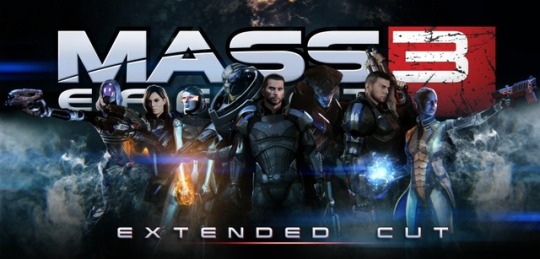
My second review will, without a doubt, make some people mad; not just because what I’m going to say about this piece will fiercely disagree with what many people had to say about it, but because Mass Effect 3 had such a large and passionate following, that it would be impossible not to offend someone.
So without further ado, here’s:
Why Mass Effect 3′s Ending Was Actually Good and Those Who Complained About It Are Being Babies (Spoilers)
(People are allowed their opinions, I don’t think they are actually babies, just that they expected too much and they had a huge overreaction to what essentially ends up being about 10-20 minutes of a 30 hour game. I want to acknowledge I’ve seen some arguments saying that the ending isn’t what people wanted. People wanted Shepard to win and to live happily ever after with his love interest with a happy family. The end. And I will admit, I wanted that for my Shepard too, but I can accept that it didn’t happen. Because what we want, isn’t always what we get. And even if you do everything right, things may not turn out the way we had wanted or expected. That’s were the emotion comes in. When Shepard fails to survive even when he made all the right calls. That’s just how it happens/happened. So if you say the ending is bad for this reason, I have no sympathy for you, and you are, in fact, a baby.)
I’m going to start by saying this is not a review of Mass Effect 3. I will review Mass Effect as a series later, but for now let’s focus on the point of contention that most people had with the game: The ending.
So being a huge Mass Effect nerd I’ve spend a lot of time in this universe (I counted it up the other day, I’ve played over 2000 hours of the Mass Effect series) which has allowed me to fully grasp and understand what goes on in these games. This also gives me a huge bias towards the game that I will fully acknowledge. However, I propose that from a writing and programing standpoint, this game (and the ending) is pretty good, not perfect, but good.
Alright legitimacy established, hypothesis stated, let’s get into the nitty-gritty. So we have 2 characters, the Illusive Man and Admiral Anderson plus a Shepard (your male/female projection of yourself that allows you to interact with the world, i.e. not actually a character). The Illusive Man is a master manipulator running a splinter military organization in order to further humanity’s status in the galaxy, at any cost necessary. He has been implanted and indoctrinated by the Reapers, but not directly controlled by them, just influenced. Opposing him, you and Anderson stand, in a trance induced by the Illusive Man via Reaper tech. Anderson is a leader of the Alliance forces, proud and humble all a the same time. He’s been friends with/mentor to Shepard for years, and has been a large part of stopping the Reapers thus far. These two characters are foils, exact opposites that highlight each others strengths and weaknesses. However this scene plays out, Anderson and the Illusive Man end up dead and Shep near death. BUT not before each character has had a chance to make an appeal to you. Illusive Man wants to control the Reapers and use their tech to make the galaxy a better place, great idea, but how is one supposed to control the Reapers? Anderson says to destroy the Reapers, anything less will be damnation of the sapient races of the galaxy, and he has a point, the Reapers are the antagonists after all. But how do we do that? They are just so powerful it has been impossible up to this point.
That’s where the MacGuffin comes in. That’s right, the Crucible, a giant space device passed down throughout millions of years of development has just been activated and Shep can die in peace knowing he kills the Reapers. But wait, what through yonder window breaks, tis a message that it doesn’t work. Shep passes out and then we see him ascend via unknown force into the Crucible.
This is the point in which I see people getting mad.
Shepard wakes inside the Crucible approached by a semi translucent little boy, that has all the answers in the universe. He says, I offer 3 different color solutions to the problem, and because you are space Jesus you get to pick which one happens by sacrificing yourself, the end. Okay, I understand that sounds dumb, and that’s why people don’t like it. There is an out of left field, totally unexpected thing happening, that boils down to a color-coded trinary choice that ends the magnificent series about the consequences of choice, right?
Wrong. Let’s unpack everything we know, and make an effort to understand before we start to judge.
First the child. Everyone seems to criticize Bioware for making the “Star Child”, as the community refers to him, a significant part of the story. The “Star Child” is based off of a child in the intro of the game. Shepard looks out of his office on Earth (that’s important) down on the child (the first young child we’ve seen in the games to this point, i.e. important), who is playing with a toy in the garden. The Reapers then launch the invasion of Earth and Shepard soon after encounters the boy in a small vent that Shep can’t fit into (also important) and tries to help him. The boy replies, “You can’t help me” (IMPORTANT!). He then disappears. Later, Shepard is about to leave Earth to unite the rest of the galaxy and beat the Reapers. There is a touching scene where Anderson gives his spiel about staying at home and fighting the good fight for the citizens of Earth. I can’t do it justice in this review, but it’s been decided that Shep will leave despite not wanting to. As his ship begins to take off, he spots the boy get into an evac shuttle. And the ship is destroyed. The boy then haunts Shep in his dreams after every major mission in the game hence forth. In each dream sequence, we an extended look at the end of the dream, where the boy sits in flames, then in the last Shepard sees himself and the boy burning. These dream sequences got labeled by fans as out-of-place, unnecessary, and stupid. These are ignorant claims, because almost everyone making these claims do not understand why the child should be important enough to haunt Shepard. They say, “Shep is a grizzled war vet who has seen atrocity after atrocity, why would one child dying haunt his dreams? Shouldn’t it be the friends he’s lost?” Now already, these people can’t understand the ending, because they’ve missed a huge themeing device, because they can only take things literally. Going back to the beginning, we start on Earth. Home. Home is associated with safety, comfort, our childhoods. Then we see the first child in the series ever, hinting that this child will be important. More than that children are considered innocent and the future. Then seeing the child in danger again in the vent, we are supposed to see that Shepard cannot reach this innocence, his future. And finally the giant walking metaphor says, “Player, you cannot help me. You cannot keep your innocence. You may never reach your future. Saving everyone is not a possibility, even thought it is your goal to save as many people as possible. Don’t expect every battle to be a victory.”
And if it wasn’t blatant enough for you, the writers decide that the child should die, AND constantly remind you of the themes via dream sequences at appropriate intervals through the story. This also builds up to a climax, in the last dream sequence when Shep and the boy perish in flames together, both foreshadowing some of the possible endings, and implying that Shepard will not see the future.
“But then how/why did the “Star Child” appear to Shepard as the boy?”
One, it’s the most ancient and advanced piece of technology in the universe with mind altering power, and you just plugged the biggest battery ever created into it. I’m sure it could have appeared as anything it wanted to. Two, themeing is important. Three, suspension of disbelief. This is sci-fi, get used to it.
Okay, so first point of contention, gone. The “Star Child” is important and now you know why. Now the Blue/Green/Red ending. I feel this was what the majority of people were mad about.
First off, I’m throwing the argument "it didn’t incorporate any of the decisions that I made previously and that’s why it’s bad” in the trash. Why? It’s not a good argument. There is no way to make a branching code that would have incorporated decisions made over the course of 3 very long games into the ending AND made it a coherent and satisfying ending to the trilogy. That’s unrealistic. Second, the decisions made did/do matter, they are what led Shepard to be in that situation. The “Star Child” literally says that in his speech. Plus the decisions matter in the much larger scale of each person’s own personal game; who lived and died, what races survive the apocalypse, the relationships forged, people affected, and everything that is and was. If you think the ending negates those decisions, you’re wrong.
Getting into each ending specifically Control, Destroy, and Synthesis; each has their own merits and affect the galaxy after Shepard. (There is also a secret fourth ending, but it isn’t quite as satisfying.) This also matters. It is a metaphor of choosing the legacy you want to leave behind. Each has its own consequences: Control is the proposition of one of your enemies, the Illusive Man. What seemed impossible is now a possibility. Can you see past the bad things that he had done and see the logic in the solution he was seeking? Or do you go with what his foil and your friend, Anderson, would have done and destroy the Reapers? It has always been your goal, but the cost is the deaths of some of your friends and allies. Or do you ignore both extremes and come to a solution never available to you before, blurring the lines between synthetic and organic. This is the most mysterious of the options, and you may not fully grasp the concept as it is foreign, but it would seem like a paradise. And yes each one had their own color, but to boil down those decisions to just the colors, is showing your own ignorance of said consequences. And with the addition of the FREE Extended Cut ending, it fills in all of the gaps that the previous iteration neglected to mention.
The decision is up to you/Shepard, but only you have to live with the consequences of your decision. And you get to see some of those consequences, as each ending has it’s own unique narration, showing outcomes of decisions made previous to the ending and what the galaxy does with the opportunity given to them.
That is a fucking great ending.
#mass effect#mass#effect#ending#endings#mass effect ending#mass effect endings#mass effect 3#mass effect 3 ending#mass effect 3 endings#analysis#game analysis#story analysis#mass effect analysis#mass effect 3 analysis#ending analysis#mass effect ending analysis#mass effect 3 ending anaylsis#babies cry when they don't get what they want#you don't always get what you want#the rolling stones are cool too#fun tags#mass effect good#good ending#happy ending#good endings#happy endings#review#game review#spoilers
3 notes
·
View notes
Text
off the rack #1296
Monday, January 13, 2020
I knew my dad had an older brother living in Edmonton but I've never met him. I was introduced to him recently when my cousin sent me a picture of Uncle #2 taken while he visited with him and his other cousins there. I showed my dad the picture of his brother and his face lit up in a big smile. He hasn't seen him in decades. Uncle #2 is 91-years-old now and he and dad are the only surviving children from grandpa's first wife. I was glad that I gave my father that moment of happiness.
Harley Quinn & Poison Ivy #5 - Jody Houser (writer) Adriana Melo (pencils) Mark Morales (inks) Hi-Fi (colours) Gabriela Downie (letters). The trail to the Floronic Man leads the ladies to Manhattan's Central Park where they are met with a surprise. No, it's not Batwoman who guest stars this issue. It's a great cliffhanger to next issue's finale.
The Immortal Hulk #29 - Al Ewing (writer) Joe Bennett (pencils) Ruy Jose, Belardino Brabo & Cam Smith (inks) Paul Mounts (colours) VC's Cory Petit (letters). Roxxon sets a trap for the Hulk and it works. This is where monsters dwell. The scene with Betty and Bruce in the cafeteria was great.
The Dollhouse Family #3 - M. R. Carey (writer) Peter Gross (layouts) Vince Locke (finishes) Cris Peter (colours) Todd Klein (letters). We catch up with Alice as an adult while the flashbacks to the past shows us some weird creatures in a cave. The dollhouse makes a couple of appearances in each point in history but we don't learn much more about it. It's still really creepy though. The last page came as a total shock. I like this DC Black Label book.
Excalibur #5 - Tini Howard (writer) Marcus To (art) Erick Arciniega (colours) VC's Cory Petit (letters). This is the payoff issue for the first story arc and I'm out of here now. My biggest complaint about this book is that I find myself wondering what the heck is going on as I'm reading. I feel disconnected with the action because of the different locations and all the mutants involved. There's a major change to a major hero so you may want to stick around to see where that goes.
Young Justice #12 - Brian Michael Bendis (writer) John Timms (art) Gabe Eltaeb (colours) Wes Abbott (letters). It was nice to see Warlord even though he was only in 4 pages of this massively dialogued issue. This book had just as many heroes running around and different locations for action as Excalibur #5 and yet not once did I feel confused or disoriented. I loved how all the Wonder Comics heroes were brought together. Especially that Miguel, the Dial H for Hero kid changed into a Miles Morales-like super hero at the end. This 12-issue run was Fun with a capital F.
X-Force #5 - Benjamin Percy (writer) Joshua Cassara (art) Dean White & Rachelle Rosenberg (colours) VC's Joe Caramagna (letters). There's plenty of force this issue as Domino and Forge go to rescue Wolverine and Kid Omega. This new thing where every mutant can be resurrected if they die has me wondering when I'm going to get tired of writers killing characters just for shock value. Plus, the mutants can't lose now. So what if you die on a mission? I'm afraid I'm going to get bored with these characters again until the next big change.
Catwoman #19 - Joelle Jones (writer) Geraldo Borges, Aneke & Inaki Miranda (art) FCO Plascencia, John Kalisz & Laura Allred (colours) Saida Temofonte (letters). Selina comes to the rescue of family and friends and is partially successful. I like the new costume.
Black Cat #8 - Jed MacKay (writer) Dike Ruan & Annie Wu (art) Brian Reber (colours) Ferran Delgado (letters). What a great issue. The Cat and the Beetle go on a heist and we get some background on Felicia's life. It was fun until the last page when things get serious.
Conan Serpent War #3 - Jim Zub (writer) Luca Pizzari (art) Frank D'Armata (colours) Vanesa R. Del Rey (art James Allison sequence) Jean-Francois Beaulieu (colours James Allison sequence) VC's Travis Lanham (letters). There's a mysterious force manipulating everybody in this story and I'm staying with it until I find out what it is.
Star #1 - Kelly Thompson (writer) Javier Pina with Filipe Andrade (art) Jesus Aburtov (colours) VC's Clayton Cowles (letters). Kelly's name in the credits made me give this a try. I'm not a fan of super villains being the star (har) of their own books but there are two women also in this comic book that I really like. If they're not enough to keep me reading then the God of Mischief certainly is.
Daphne Byrne #1 - Laura Marks (writer) Kelley Jones (art) Michelle Madsen (colours) Rob Leigh (letters). This is another creepy comic from the same imprint that puts out Basketful of Heads. It's 1886 in New York and Daphne is a very intelligent young lady who doesn't fit in with the others at Miss Farrow's School for Girls. Her mother is a patron of a psychic who claims to have communicated with Daphne's dead father. That may be a hoax but her dreams seem to be all too real. I miss seeing Kelley Jones's art on the racks so I hope to keep reading this book as it comes out.
Ruins of Ravencroft: Carnage #1 - Frank Tieri (writer) Angel Unzueta (modern day art) Guiu Vilanova (flashback art) Rachelle Rosenberg (colours) VC's Travis Lanham (letters). I saw the ads for this and didn't think I would be interested but I liked the art when I flipped through it so took it to read. Other than being connected to Carnage from the title I didn't know anything about this comic book, but seeing Misty Knight on the second page meant that I had something familiar to anchor myself. And then Mayor Wilson Fisk shows up. Ravencroft is New York's version of Arkham Asylum and it was a major location during the Absolute Carnage story. It's being torn down to be rebuilt and this issue gives us the history of the evil ground that it's built on. This establishes that the Venom and Carnage symbiotes have been around since forever because the history starts in the early 1400s. I don't know where this series is going but I liked it enough to want to check out the next instalment hitting the racks January 15, Ruins of Ravencroft: Sabretooth.
The Clock #1 - Matt Hawkins (writer) Colleen Doran (art) Bryan Valenza (colours) Troy Peteri (letters). Again, it was the art that prompted me to pick this off the rack. I first appreciated Colleen's art in 1983 when she put out "A Distant Soil". I loved her detailed pen and ink work in black and white. Here she is in colour and it still moves me. Her expressions really convey what the characters are feeling. The story is about a cancer epidemic and the threat to the world's population seems credible. I'm going to follow young scientist Jack to see how he saves the world.
Marvels X #1 - Alex Ross & Jim Krueger (writers) Well-Bee (art) VC's Cory Petit (letters). I really liked the first Marvels series by Kurt Busiek and Alex Ross showing the Marvel U through the eyes of regular people. This latest story features a young super hero fan named David trapped in his house after what seems to be the worldwide Terrigen Mist event when Marvel tried to make the Inhumans a big deal. David's entire family is lost and now he's off to New York City to find his heroes. I liked the kid so I'm going to follow his adventures.
Miles Morales: The End #1 - Saladin Ahmed (writer) Damion Scott (art) Dono Sanchez-Almara (colours) VC's Cory Petit (letters). This $4.99 US one-shot really is the end for Miles. He lives to be a ripe old age and goes down fighting. I would only recommend this for collectors of all things Miles.
Deadpool #2 - Kelly Thompson (writer) Chris Bachalo (pencils) Wayne Faucher, Livesay, Al Vey, Jaime Mendoza, Victor Olazaba & Tim Townsend (inks) David Curiel (colours) VC's Joe Sabino (letters). I don't find Wade's new role as King of Staten Island, where monsters dwell, to be very interesting so I'm not going to read anymore of this. Much as I like Chris Bachalo's art, it's not enough to keep me coming back every month.
20XX #2 - Jonathan Luna & Lauren Keely (writers) Jonathan Luna (art & letters). We find out what newly minted Sym Meria's power is and how she's going to cope with it. The developments with the East Side and West Side gangs and Meria's new friend are interesting enough to make me want to read the next issue of this black and white book.
Fallen Angels #5 - Bryan Hill (writer) Szymon Kudranski (art) Frank D'Armata (colours) VC's Joe Sabino (letters). The team is set. Psylocke leads X-23, young Cable, Husk and Bling to Dubai to fight the super villain Apoth. The foreshadowing on the last page ratchets up the anticipation for the next issue.
The Amazing Spider-Man #37 - Nick Spencer (writer) Ryan Ottley (pencils) Cliff Rathburn (inks) Nathan Fairbairn (colours) VC's Joe Caramagna (letters). Now that Absolute Carnage is done, it's time for Peter Parker to get back into the swing of things. He's testing a new device called the Clairvoyant that can predict what might happen in the future. I predict it's going to screw up his life big time down the road. The one thing I'm excited about is that a plotline that was put on the back burner is now cooking with gas. Kindred is back and he's hinting at how he's going to confront Spider-Man. As big a Spider-Man fan that I am, I still have no clue who this new super villain is.
Batman #86 - James Tynion IV (writer) Tony S. Daniel (pencils) Danny Miki (inks) Tomeu Morey (colours) Clayton Cowles (letters). Let's welcome the new writer. He's got a tough act to follow but he starts his first story off very well. Batman gets wind of something big going down in Gotham City and has to deal with paid assassins gathering for nefarious purposes. There are major changes to get used to, the least of which is that Alfred is gone. Same with James Gordon, and the new Police Commissioner was a surprise. I probably would have continued to read this book because the art is so nice. Selina in the LBD at the fund raiser, MeeOwww.
Savage Avengers #9 - Gerry Duggan (writer) Patch Zircher (art) Java Tartaglia (colours) VC's Travis Lanham (letters). Conan holds his own as Doctors Doom and Strange battle Kulan Gath. When Stephen is felled by sorcerous venom Doctor Doom comes to the rescue. The amalgamation of the two Doctors was a fun surprise. If would be cool if the Iron Mage stuck around after this story.
Joker: Killer Smile #2 - Jeff Lemire (writer) Andrea Sorrentino (art) Jordie Bellaire (colours) Steve Wands (letters). The doctor is out, of his mind that is. The Joker has gotten into Dr. Arnell's head in this psychological thriller. I don't imagine that things are going to end well for the good doctor in next issue's finale. Thanks to Doug for lending me his copy to read after we sold out on the racks.
0 notes